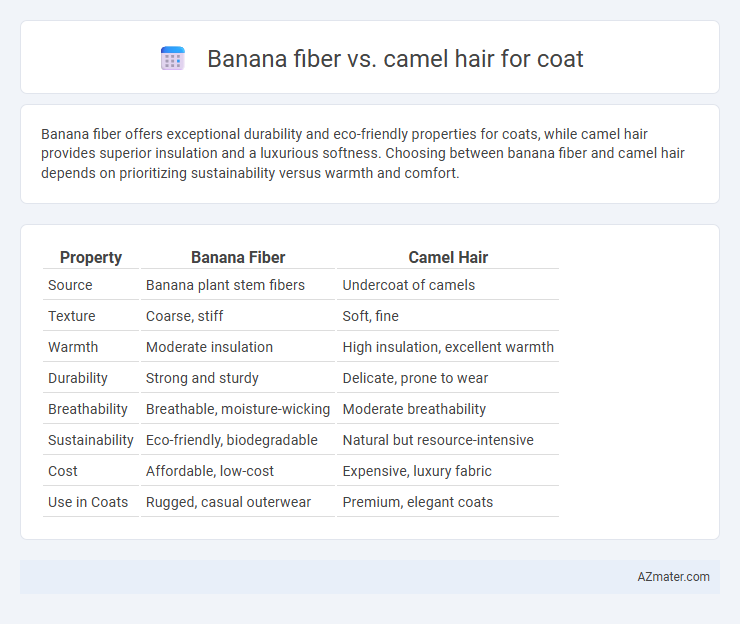Banana fiber offers exceptional durability and eco-friendly properties for coats, while camel hair provides superior insulation and a luxurious softness. Choosing between banana fiber and camel hair depends on prioritizing sustainability versus warmth and comfort.
Table of Comparison
| Property | Banana Fiber | Camel Hair |
|---|---|---|
| Source | Banana plant stem fibers | Undercoat of camels |
| Texture | Coarse, stiff | Soft, fine |
| Warmth | Moderate insulation | High insulation, excellent warmth |
| Durability | Strong and sturdy | Delicate, prone to wear |
| Breathability | Breathable, moisture-wicking | Moderate breathability |
| Sustainability | Eco-friendly, biodegradable | Natural but resource-intensive |
| Cost | Affordable, low-cost | Expensive, luxury fabric |
| Use in Coats | Rugged, casual outerwear | Premium, elegant coats |
Introduction to Sustainable Coat Materials
Banana fiber and camel hair are gaining attention as sustainable materials for coats due to their natural origins and eco-friendly properties. Banana fiber is derived from the pseudostem of banana plants, offering biodegradability and high tensile strength, while camel hair provides excellent insulation and durability from a renewable source. Both materials contribute to reducing environmental impact by minimizing reliance on synthetic fibers and promoting ethical sourcing in sustainable fashion.
Overview of Banana Fiber and Camel Hair
Banana fiber, derived from the pseudostems of banana plants, offers a sustainable and eco-friendly textile option known for its natural strength, breathability, and moisture-wicking properties, making it suitable for lightweight and durable coats. Camel hair, obtained from the undercoat of Bactrian camels, is highly valued for its exceptional warmth, softness, and insulation, often used in luxury winter coats due to its fine texture and natural thermal regulation. Both fibers present unique benefits in coat manufacturing, with banana fiber emphasizing sustainability and breathability, while camel hair prioritizes warmth and comfort.
Source and Harvesting Processes
Banana fiber is extracted from the pseudostem of banana plants after the fruit harvest, utilizing a renewable agricultural byproduct with a labor-intensive retting and stripping process to separate the cellulose fibers. Camel hair is collected from the undercoat of Bactrian camels through combing during seasonal molting, involving careful manual gathering to ensure softness and insulation properties. Both fibers represent sustainable natural textiles but differ significantly in origin: banana fiber derives from plant waste, while camel hair is animal-sourced, influencing their ecological footprints and harvesting complexities.
Environmental Impact Comparison
Banana fiber is a sustainable textile made from the agricultural waste of banana plants, offering biodegradability and reducing environmental pollution by minimizing waste. Camel hair, derived from the undercoat of camels, is renewable and natural but requires more extensive animal husbandry practices that may impact land use and water resources. Compared to camel hair, banana fiber production has a lower carbon footprint and water consumption, making it a more eco-friendly choice for coat manufacturing.
Texture and Feel: Banana Fiber vs Camel Hair
Banana fiber has a coarse texture with a slightly rough feel, offering a natural, rustic appearance often used in eco-friendly fashion. Camel hair, on the other hand, is exceptionally soft and smooth, providing a luxurious warmth and a silky touch ideal for high-end coats. While banana fiber emphasizes durability and breathability, camel hair excels in softness and insulation, making each suitable for different coat preferences based on texture and comfort.
Durability and Longevity of Coats
Banana fiber coats offer notable durability due to their strong cellulose structure, making them resistant to wear and tear over time, while camel hair coats are prized for their natural resilience and ability to retain warmth without heavy fabric degradation. Camel hair fibers have excellent elasticity and a fine texture, contributing to their longevity through repeated use, whereas banana fiber, being more rigid, may require specialized care to maintain its structural integrity. Both materials provide long-lasting durability, but camel hair tends to outperform banana fiber in maintaining softness and comfort over extended periods.
Insulation and Warmth Properties
Banana fiber offers excellent breathability and moderate insulation, making it suitable for lightweight coats in mild weather but less effective in extreme cold compared to camel hair. Camel hair provides superior warmth due to its fine, hollow fibers that trap heat efficiently, making it ideal for heavy winter coats. Its natural insulation and softness ensure exceptional comfort and durability in harsh climates.
Breathability and Comfort
Banana fiber coats offer excellent breathability due to their natural moisture-wicking properties, keeping the wearer cool and dry in varying climates. Camel hair coats provide superior insulation and softness, enhancing comfort in colder conditions by retaining heat without causing overheating. Choosing between banana fiber and camel hair depends on prioritizing lightweight, breathable comfort versus warmth and plush texture.
Aesthetic and Design Versatility
Banana fiber offers a natural, textured aesthetic with a matte finish that complements eco-conscious and rustic designs, ideal for coats seeking a unique yet understated appearance. Camel hair boasts a luxurious, soft, and smooth texture with a slight sheen, providing timeless elegance and versatility in both classic and modern tailored coat styles. The inherent durability of banana fiber supports bold, structured silhouettes, while camel hair's flexibility allows for refined draping and intricate detailing in high-end fashion coats.
Cost and Market Availability
Banana fiber coats are generally more cost-effective due to the sustainable agricultural byproduct used in production, making them accessible in niche eco-friendly markets. Camel hair coats often come with a higher price tag, reflecting the labor-intensive collection process and their luxury status in traditional outerwear segments. Market availability for banana fiber remains limited but growing in sustainable fashion circles, while camel hair enjoys widespread presence in high-end retailers and specialized boutiques.

Infographic: Banana fiber vs Camel hair for Coat
 azmater.com
azmater.com